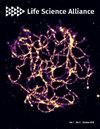人体脂肪分布基因的系统遗传学分析确定了脂肪细胞过程。
IF 3.3
2区 生物学
Q1 BIOLOGY
引用次数: 0
摘要
腹部脂肪过多是心血管代谢疾病的一个性别二态风险因素,近似值为根据体重指数调整后的腰臀比(WHRadjBMI)。虽然这一特征具有高度遗传性,但已知的致病基因却很少。我们的目的是利用系统遗传学来确定 WHRadjBMI 的新驱动因素。我们使用了两个独立的脂肪组织基因表达队列,并构建了针对不同性别和部位的贝叶斯网络,以模拟 8492 个基因之间的相互作用。通过关键驱动因素分析,我们确定了在硅学和体外可能调控其他许多基因的基因。每个网络中的 51-119 个关键驱动因子在两个队列中都得到了重复。在其他细胞类型中,这些基因中有 23 个存在于关键的脂肪细胞通路中:Wnt信号转导或线粒体功能。我们在人类皮下前脂肪细胞中过量表达或下调了七个关键驱动基因。关键驱动基因ANAPC2和RSPO1抑制了脂肪的生成,而PSME3则促进了脂肪的生成。RSPO1 增加了 Wnt 信号活性。在分化的脂肪细胞中,MIGA1和UBR1的下调导致线粒体功能障碍。这五个基因调控脂肪细胞的功能,我们推测它们调控脂肪的分布。本文章由计算机程序翻译,如有差异,请以英文原文为准。
Systems genetics analysis of human body fat distribution genes identifies adipocyte processes.
Excess abdominal fat is a sexually dimorphic risk factor for cardio-metabolic disease and is approximated by the waist-to-hip ratio adjusted for body mass index (WHRadjBMI). Whereas this trait is highly heritable, few causal genes are known. We aimed to identify novel drivers of WHRadjBMI using systems genetics. We used two independent cohorts of adipose tissue gene expression and constructed sex- and depot-specific Bayesian networks to model gene-gene interactions from 8,492 genes. Using key driver analysis, we identified genes that, in silico and putatively in vitro, regulate many others. 51-119 key drivers in each network were replicated in both cohorts. In other cell types, 23 of these genes are found in crucial adipocyte pathways: Wnt signaling or mitochondrial function. We overexpressed or down-regulated seven key driver genes in human subcutaneous pre-adipocytes. Key driver genes ANAPC2 and RSPO1 inhibited adipogenesis, whereas PSME3 increased adipogenesis. RSPO1 increased Wnt signaling activity. In differentiated adipocytes, MIGA1 and UBR1 down-regulation led to mitochondrial dysfunction. These five genes regulate adipocyte function, and we hypothesize that they regulate fat distribution.
求助全文
通过发布文献求助,成功后即可免费获取论文全文。
去求助
来源期刊

Life Science Alliance
Agricultural and Biological Sciences-Plant Science
CiteScore
5.80
自引率
2.30%
发文量
241
审稿时长
10 weeks
期刊介绍:
Life Science Alliance is a global, open-access, editorially independent, and peer-reviewed journal launched by an alliance of EMBO Press, Rockefeller University Press, and Cold Spring Harbor Laboratory Press. Life Science Alliance is committed to rapid, fair, and transparent publication of valuable research from across all areas in the life sciences.
 求助内容:
求助内容: 应助结果提醒方式:
应助结果提醒方式:


